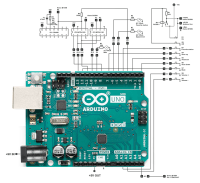Retro tuning - Arduino driven TDA7010T FM Receiver

The project describes how to realize an Arduino-controlled FM receiver from the last century with many new functions.
A few weeks ago I came across the interesting Kemo B156N kit while browsing through my electronics collection. This is an FM receiver which is based on the integrated TDA7010T module. This is the successor to the already legendary TDA7000 from the last century. The older Elektor readers will certainly still be familiar with this highly integrated chip. All that was needed was a few passive components to build a high-reception Superhet FM receiver. The tuning was done using a potentiometer, which changed the voltage of a capacitance diode.
Now the idea came to me to give this analog receiver more functionality and I thought about what could be possible with today's resources without much effort. I spontaneously thought of the all-rounder Arduino, which provided pretty much all the functions that were needed: switching inputs, switching outputs, A/D converters and PWM outputs.
My feature requirements were as follows:
• Auto scan function
• Save favorite stations
• Digital volume control
• Mute button
• Field strength display
• Frequency display
• Favorites display
• Save the last selected favorite
• Save the last selected volume
• On-Off button
Read in the attached document how this idea was realized.
Now the idea came to me to give this analog receiver more functionality and I thought about what could be possible with today's resources without much effort. I spontaneously thought of the all-rounder Arduino, which provided pretty much all the functions that were needed: switching inputs, switching outputs, A/D converters and PWM outputs.
My feature requirements were as follows:
• Auto scan function
• Save favorite stations
• Digital volume control
• Mute button
• Field strength display
• Frequency display
• Favorites display
• Save the last selected favorite
• Save the last selected volume
• On-Off button
Read in the attached document how this idea was realized.





Updates from the author
JoergT 1 year ago
- Main circuit diagram corrected
- Programm comments corrected
Yılmaz delsa aksu 1 year ago
HELLO, I AM AN AMATEUR ELECTRONICIST. DO YOU HAVE A PCB DRAWING FOR THIS PROJECT
delsayilmaz@hotmail.com
TEL WATSAP:05065024954
JoergT 1 year ago